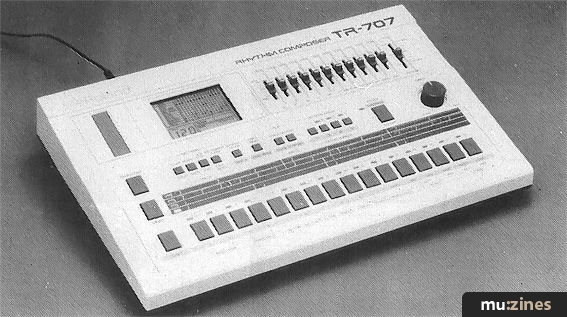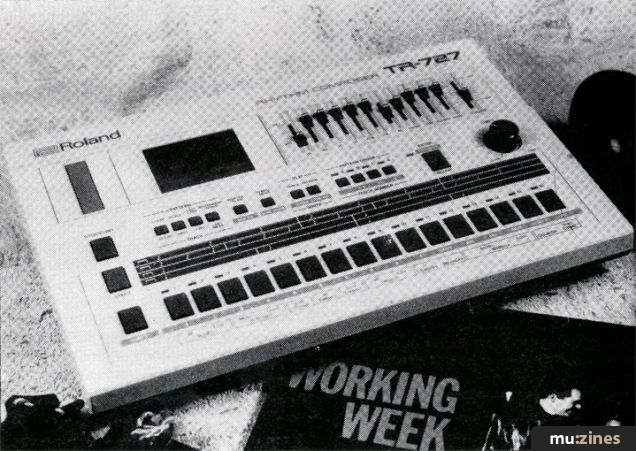Magazine Archive
Home -> Magazines -> Issues -> Articles in this issue -> View
Roland TR-707 | |
RhythmcheckArticle from International Musician & Recording World, January 1985 | |
Where the 110 meets the 909. Bob Henrit investigates

The perfect budget/quality hybrid
Roland, without a shadow of a doubt, make more drum machines than any other company. As a matter of fact, they now make so many that it would appear they've had to drop one to allow their latest, the 707, to come onto the market. Reading from the bottom in terms of superiority, they make 110, CR5000, CR8000, 606, 707 and 909. The old DR55 was dropped last year, and they've now sent the 808 to the drum-machine graveyard. (It would appear to have been overtaken by digital superiority).
707 is interesting in that it's something of a hybrid. It incorporates features from the cheapest and most expensive Roland machines. It uses the wonderful and useful graphic display from the 110 and the same sort of assigning features and digital sounds to be found on the 909.
This particular rhythm composer is housed in a plastic 'box' which does not look too dissimilar to the 909's. It is smaller, though, and since it is battery powered, is much lighter. (Before you begin to panic unnecessarily, I must tell you that you aren't doomed to spending the rest of your lives financing that battery company with the drumming bunnies, because Roland supply you with a power supply for free). As per usual, there's a bunch of switches and buttons on the top, and the usual array of inputs and outputs along the back edge.
As we scan the top of the unit (from left to right) we find a RAM cartridge slot to enable us to load information into the 'machine' quickly. This slot accepts one of Rolands' M64 cartridges (complete with internal battery back-up) and is, of course, the alternative to using the ins and outs on the back of the machine to store information on audio cassette. Next to this is the aforementioned display which serves as an aid to 'step time' programming as well as displaying other features. It will show Modes, Tempo in beats per minute and in short tell you what the 707 is thinking. The top part of the window is a grid of vertical and horizontal lines. The East to West lines pertain to the voices of the percussion instruments. They descend through bass drum, snare drum, tom tom etc. The North to South lines correspond to beats in the bar.
They form 16 squares which divide the bar up neatly into semiquavers. All one needs to do to programme is advance a blob sideways across the screen/grid; to 'plant' it we only have to press the relevant voice button. If we don't 'plant' a beat and simply advance another square, then a semi-quaver rest will result, it's simplicity itself, and in the Play mode a handy graphic illustration of the pattern playing will come upon the screen.
Further to the right of the 'display' are a series of sliding faders. There are actually 11 of these which control the levels of all the different voices (and accent) as well as overall volume. Moving geographically to the West side of the unit we find a trio of large rectangular buttons. These control Stop/Cont, Start and Shift. (Since many of the controls are dual-function, this last button is very important).
Stretching horizontally to the other side from there are a series of smaller function buttons. These are the ones which are affected by Shift, and so have their designations printed above and below. One simply presses Shift for the bottom function. So, the first will Clear in either mode (Pattern or Track), the next is for Scale or Back, then Last Step and Forward (In steptime), then Instrument/Guide or Last Measure. The next button is for Shuffle/Flam or MIDI and the one next to it controls Tempo/Measure on the screen or alternatively Sync Mode. Two more buttons are to the left of these to look after the Play and Write functions and they also work as Step and Tap. Finally we find four identical buttons which select which track we're writing on; 1, 2, 3 or 4.
There are four Pattern groups too; A, B, C and D. These, as you can appreciate, give us 16 separate positions to store our rhythm patterns. Of course we need to use the shift button too for this manoeuvre but all the relevant info will be thrown upon the screen. There's an Accent button too which doubles as Enter and Cartridge select and finally a rotary potentiometer.

A similar graphic display to the 110
The same sort of scale which used to be on the 808 is printed below this as an aid to programming. It relates to resolution of our patterns. It shows the divisions of notes and has an LED to show which one we're working with.
The only other buttons are the voice activators. We have Bass Drums (1 and 2), Snare Drums (1 and 2), Low, Mid and High Toms, Rimshot (ie stick across rim) and Cowbell, Handclap, Tambourine, Hi Hat closed, Hi Hat open, Crash and Ride cymbal. The last few voice buttons also double as Copy, Insert, Save, Verify and Load, respectively. I mentioned earlier that the back edge has jack-sockets to output the signals of all the voices separately. These sockets are made of plastic and take your normal instrument type plug. They also provide us with a left and right stereo (fixed picture) pair of sockets; the right one is designed to work in Mono. There's a very important headphone socket, a Start/Stop pedal socket, a programmable Trigger 'out', as well as Sync Out and Sync In. There's also Save and Load for storing info on cassette. This enables the user to have more memory to play with; so does the RAM pack. The only other features of the back are a pair of five pin DIN sockets from MIDI, a 12-volt dc 'in' and a power switch. The MIDI facility will enable us to join the 707 to other compatible machines and work together. You can also control the voices from a keyboard if you so desire. (You simply find the voices on certain keys in the octave below middle C. For some reason you get toms duplicated on adjacent higher keys. Closed hi hat too is affected).
The voice sounds were not too shabby at all. One of the bass drums is accented, while one of the snares has a slightly lower pitch. The toms were reasonable while the hand clap sounded synthesized to me. It's odd this because I had expected to find all the sounds to be digitally sampled via PCM. Roland's tambourine proved to be a little too thin for my taste, but with individual outputs it wouldn't be difficult to thicken it up. The cowbell appeared to have a touch of 'room' reverb on it which I liked too. The hi hat was reasonably reasonable as was the 'crash' which was fairly long. I was not impressed with the 'ride' cymbal, it seemed to me that a Jazzy sort of instrument had been sampled. It wasn't that it had been recorded badly, it simply was a bit 'wet'. Memorywise the 707 will contain, if you so wish, up to 64 kinds of rhythm pattern in four groups of 16. It will also have a maximum measure of 998 bars. Its flam function can be applied to snare drum number two and all three toms, and is adjustable in distance before the main beat. Shuffle, too, can have its 'gap' adjusted.
I was criticised recently for going too far into the programming capabilities of a certain machine. My detractor said that as far as he was concerned any piece of equipment on the shelves these days would have its idiosyncrasies and it was a question of learning about the machines as you went along. Of course he's right. The main thing to remember is that any piece of 'state of the art' equipment will take time to get used to. Having said all this, the Roland 707 is very good. Unfortunately I didn't have the luxury of a week to 'grow into' it, but I managed. The price is certainly right and the name of the product certainly precedes it.
Also featuring gear in this article
A Runway Success
(ES Jan 85)
Roland TR707 - Digital Rhythm Composer
(EMM Dec 84)
Roland TR707
(IT Jan 85)
Roland TR707
(12T Feb 85)
Roland TR707
(HSR Sep 85)
TR-707 - The Record Maker
(IM Mar 85)
Browse category: Drum Machine > Roland
Featuring related gear
Computer Page - Roland MKS-7 Super Quartet
(IM Sep 86)
It's Latin for Rhythm
(IM Apr 85)
Latin Lessons
(EMM Aug 85)
Roland MKS7
(12T Dec 85)
Roland TR727 Rhythm Composer
(IT Dec 85)
Browse category: Sound Module > Roland
Browse category: Drum Machine > Roland
Publisher: International Musician & Recording World - Cover Publications Ltd, Northern & Shell Ltd.
The current copyright owner/s of this content may differ from the originally published copyright notice.
More details on copyright ownership...
Review by Bob Henrit
Previous article in this issue:
Next article in this issue:
Help Support The Things You Love
mu:zines is the result of thousands of hours of effort, and will require many thousands more going forward to reach our goals of getting all this content online.
If you value this resource, you can support this project - it really helps!
Donations for November 2025
Issues donated this month: 0
New issues that have been donated or scanned for us this month.
Funds donated this month: £0.00
All donations and support are gratefully appreciated - thank you.
Magazines Needed - Can You Help?
Do you have any of these magazine issues?
If so, and you can donate, lend or scan them to help complete our archive, please get in touch via the Contribute page - thanks!
















